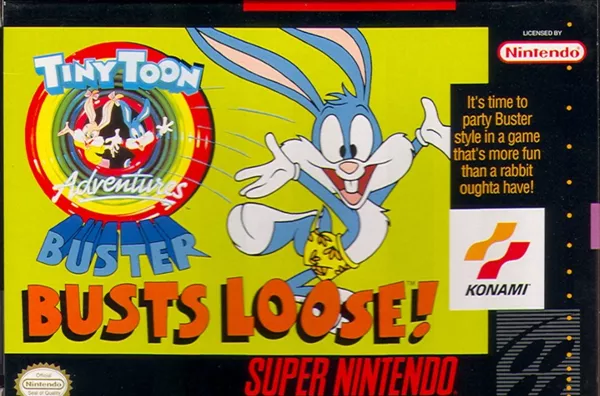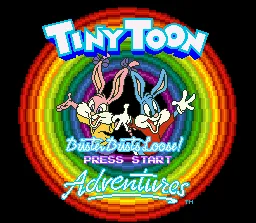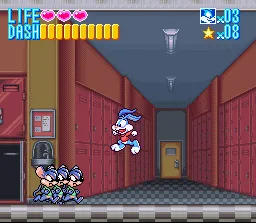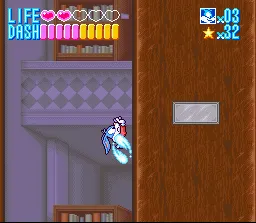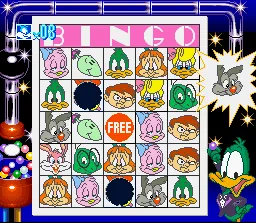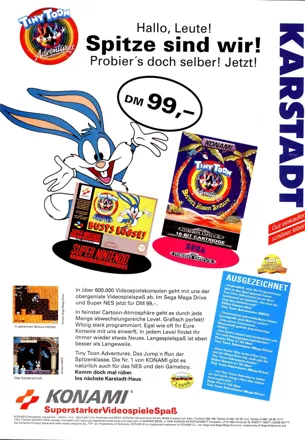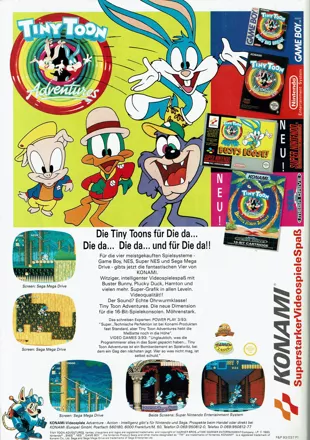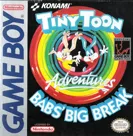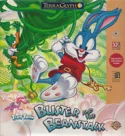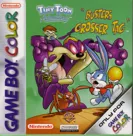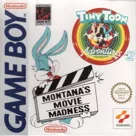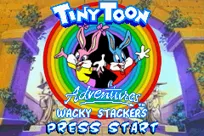Tiny Toon Adventures: Buster Busts Loose!
Description
You play Buster Bunny, in a series of levels, featuring characters from the Tiny Toon Adventures cartoon.
Most of the six levels are platform levels, where Buster has a number of attacks to defeat the enemies he faces. These include kicks and jumps, and a dash ability that lets you slide into enemies to defeat them, and also climb walls.
The fourth level is an exception, and consists of a game of (American) football, played with a simplified version of the rules. The idea is simply to get a touchdown, while as usual progressing at least ten yards in four downs. There are two plays: a running play, where you simply run as far as possible while avoiding the opposing team; and a passing play that starts with a pass that can gain you extra yards, but must be caught.
Between levels there are bonus games. You spin a wheel to determine what game you play out of five available.
Spellings
- タイニー・トゥーン アドベンチャーズ - Japanese spelling
Groups +
Screenshots
Promos
Credits (SNES version)
24 People (18 developers, 6 thanks) · View all
| Planning by | |
| Programmed by | |
| Graphics and Animations by | |
| Sound and Music by | |
| Package Designed By | |
| Produced By |
|
| Special Thanks To | |
| [ full credits ] | |
Reviews
Critics
Average score: 85% (based on 20 ratings)
Players
Average score: 3.9 out of 5 (based on 32 ratings with 3 reviews)
Deceptively simple platformer that will have you hooked!
The Good
Konami's Tiny Toon Adventures games are all brilliantly pulled off adding something a little different each time to the platform genre. In Buster Busts Loose! you take on the role of, you guessed it, Buster Bunny through a bunch of completely unrelated events which are narrated by Buster and Babs before each stage in a humourous little cut-scene. Gameplay wise Buster controls well, he is responsive and his jump is nice and springy. There are three moves you can pull off; the basic jump, a dropkick (which looks more like a bicycle kick) and Busters Dash technique which you can use to kill enemies and solve puzzles which normally involve you running up a wall and jumping to another one etc.
As I mentioned before each level is COMPLETELY different, you start in Acme Looniversity and then move on to the Western movie stage and then a haunted mansion in the middle of a forest before joining in a game of Football against a rival team of identical ducks. After each stage you get to spin a wheel with pictures of most of the main characters on it, whatever face the wheel lands on is the mini-game you get to play. My personal favourite is Furballs Championship Squash which features a really cool reflection effect off the polished hardwood floor.
The Bad
The first couple of levels are snoringly easy and then all of a sudden the difficulty level is ramped up during the Mansion stage in which you are forced to negotiate some taxing jumps, after a bit of practice these jumps become easy however it sort of hits you with this difficulty spike all of a sudden.
Occasionally I found that when I spun the mini game wheel it would repeatedly land on the same game which gets irritating after a while.
The music is stock, basic cartoon background music and I found the Western and Football game tracks to be excruciatingly annoying.
The Bottom Line
Buster Busts Loose may sound stupid but it is a deceptively simple platformer from the platforming specialist; Konami. The game is bright, colorful, addictive and utterly playable, I personally love the inclusion of the mini games between stages. I guarantee that you will enjoy this game, it is definitely one of the better platformers for the SNES. The game however is a tad short so don't be disappointed when all of a sudden it is over :P.
SNES · by AxelStone (34) · 2008
The Good
This Tiny Toon Adventures platformer was made for the Super Nintendo in 1993 by a team associated with the Goemon games for the Super Famicom. This game isn't much like Goemon but it does share a similar theme of variety, novelty, and entertaining stages with Buster running up walls, skipping rope, scoring a touchdown, playing mini-games, and traveling to space.
Unlike many platformers and previous games in the series Buster doesn't attack by jumping on his foe's head, instead he uses a weird flipping attack or a dash jump/slide. Dashing is Buster's signature move in this game and is required to get across large gaps and run up walls. Between the flipping and dashing this game has a flavor all its own.
Occasionally poor dialog aside, the game's presentation is done very well and is probably the game's strongest attribute. This might just be one of the best looking games for the SNES with lots of color, special effects only possible on the SNES, and some very well animated sprites (something I usually associate more with Genesis games). The music is also quite good although you can definitely recognize those familiar SNES sound chip instruments. The story and humor is right out of the show and, unlike other games, follows an episode-style format with each stage having its own plot.
The Bad
I first played this game as a rental when I was a kid; it didn't end well. I just couldn't get anywhere, even on the lowest difficulty, so I never rented it again (I really wanted to see that football stage too). The game just controls weird, you can't jump on enemies like in many other games and Buster's attacks are awkward. This game is also full of little counter intuitive elements such as running up walls or bosses that can be stunned but not truly damaged with normal attacks and it all seems simple and clever just as long as you get what you're supposed to do but if you don't it's a nightmare. A little lateral intelligence will definitely go a long way in enjoying this game.
The game's main design issue is that, due in large part to its unique dash move, level design has a tendency to be thrown under the bus in favor of balance in game flow. This is most noticeable in the first stage whose largely featureless hallways give so little freedom to explore and experiment that it gives you the weirdly unsettling feeling that you're playing a cut scene (unless you're like I was as a kid, then it's like you're playing a cut scene that has frozen). Later levels are more interactive but not always by much with automatic scrolling and linear level design being used way too often to either force or limit the use of Buster's dash.
The Bottom Line
Buster Busts Loose is a fine game with great graphics and highly novel stages that fans of the series will love. It's best attribute is its overall art design but its worst is its suffocating level design. You could say that this platformer has both the best and the worst aspects of a playable cartoon.
SNES · by Joey Taylor (10) · 2013
The Good
Buster, a blue and white bunny (and I suppose a vague descendant of Bugs), stars in this game based on the cartoon, which is in turn based on the classic Looney Tunes masterpieces. These pint-sized mascots represent a new generation, and being targeted at a young, modern audience (well this was in the nineties!), Buster and the gang are a bunch of energetic, colourful and mischievous characters. So, will these qualities transpose into a video-game with any success?
“Buster Busts Loose!” is like most games of this era, an attempt at a 16-bit platform game, complete with items, stomp-able enemies, an offbeat playable character and loads of places to jump around to – nothing new there. You control Buster, and you can jump, slide, flip/kick and power-jump. As an owner of three-heart containers, Buster can take reasonable damage before hitting the deck – of course, in the spirit of Link (bless him!), Buster can upgrade his containers to a total of five.
Visually, this title has a nice appeal. The colour scheme is bright and colourful, as you’d expect, and the sprites themselves are well drawn and varied. Enemies are quite strange actually, and not being a viewer of the cartoon, I can only guess that the vultures, bandits and upright albino-looking guard dogs were regular characters. The environments themselves vary well enough, and they make reasonable use out of their inherit obstacles and distinct compositions. The Wild West stage for example, features self-scrolling train-carriages and a puffing and blowing out-of-control steam engine.
How does the game actually play? Well, from the outset, you notice that Buster is pretty manoeuvrable, even if his single attack method (a sort of back flip and kick combined) does seem a little odd and sometimes useless. He’s fast, but he’s no Bubsy, (but then Bubsy couldn’t run up a vertical wall, could he?) A possessor of a dash-meter, Buster can deplete this to put on a burst of speed. This is useful for making longer jumps and the like.
The Bad
This title has a few issues in terms of its level-design. I understand that the game may be marketed for a young audience, so this may explain some of the empty, flat areas and unavoidable power-ups. But as you play along, you notice that there is not all that much to do, and that the exploratory content of the game is practically non-existent. This is most noticeable in some of the later areas, where a simple A-to-B-to-C-to-D platform hop is about as complicated as it gets. Also, pickups are few and far between and hardly needed when they are found – almost as if this game play ingredient was included out of obligation.
The Bottom Line
There are some nice Tiny Toon artistic touches throughout the game, and they feel pretty well married into the game play. The bosses feature regulars from the gang, and there are some pretty neat Bonus Stages (which is the old word for “Mini-game”!) In these, you spin a Mode 7 rendered wheel (inspired by Wheel of Fortune no doubt), to select your mini-game. These vary from average to quite fun. There’s a Bingo type game, a pretty nifty squash game, and a strange character weighing game, among others. These little mid-level adventures extend the distressingly short single player game.
Short? Yes. There are only six levels in the game, and sadly, most of them are very brief. This compact level design, coupled with the lack of exploration, gives the game a kind of living-storybook feel - and not in that clever “Paper Mario” style either. Rather, you feel as if you are going through the motions, and the game wants you to experience things at its discretion. This may be a little harsh on a 16-bit effort targeted at children, but I do remember noticing this at the time. Overall, this game has its merits, but it does seem a kind like a lightweight title, as if it was scared of being offensive or too violent. Believe me, it’s never approaches anything that a healthy four-year old can’t handle.
SNES · by So Hai (261) · 2008
Analytics
Upgrade to MobyPro to view research rankings and price history! (when applicable)
Identifiers +
Contribute
Are you familiar with this game? Help document and preserve this entry in video game history! If your contribution is approved, you will earn points and be credited as a contributor.
Contributors to this Entry
Game added by Silverfish.
Additional contributors: monkeyislandgirl.
Game added February 19, 2006. Last modified July 25, 2024.


